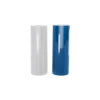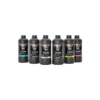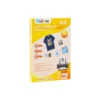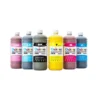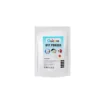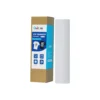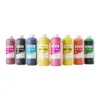The short answer is no—UV DTF is not suitable for fabric applications, especially garments. In this blog, we’ll explore why UV DTF doesn’t work well on textiles, what printing methods are better for clothing, and where UV DTF transfer film truly shines.
Why You Can’t Use UV DTF Transfer Film on Clothes
UV DTF transfer film is designed for use with UV-curable inks that are hardened (or “cured”) instantly under UV light. These inks are rigid once cured, which makes them ideal for hard, non-porous surfaces but unsuitable for soft, flexible materials like fabric.
Clothing demands flexibility, washability, and fiber-level adhesion—three things that UV DTF isn’t designed to provide. Absolutely, current technology is quite advanced, and some ink manufacturers have developed UV DTF inks suitable for printing on clothing.
However, this product is limited to small-scale printing on fabrics (e.g., apparel round label stickers) and cannot achieve large-area printing on fabrics. This blog post discusses the feasibility of this approach and points out that there are people currently attempting it.

What Works Instead of UV DTF Transfer Film on Clothes?
If you’re looking to decorate garments, there are two ideal printing technologies:
DTF Printing (Direct to Film)
- Uses water-based pigment ink + transfer film + hot melt powder.
- Applies transfers to cotton, polyester, spandex, and blends.
- Offers excellent stretch, durability, and wash resistance.
Sublimation Printing
- Works best on polyester fabrics or coated surfaces.
- Produces vivid, durable designs that are embedded in the fibers.
- Great for sportswear, activewear, and all-over prints.
Both DTF and sublimation offer the flexibility and endurance that fabrics require—something UV DTF transfer film cannot provide on its own.


What Is UV DTF Transfer Film?
UV DTF transfer film is a specialized decal medium used in UV DTF printing, a process that layers white ink, CMYK color, and varnish onto a film surface, then cures it instantly using UV light.
Once printed and laminated with an adhesive layer (B film), this decal is ready to apply onto various objects without heat.
Key Features:
- High definition graphics
- Cold peel application
- Glossy and slightly raised finish
- Suitable for most hard base materials
Likewise, here’s a more detailed article about it for your reference: What Is UV DTF Stickers?

Where Can You Use UV DTF Transfer Film?
UV DTF excels on rigid or semi-rigid surfaces such as:
- Wood – coasters, signs, ornaments
- Glass – mugs, jars, panels
- Metal – tumblers, tags, tools
- Acrylic – signage, displays
- Plastics – phone cases, packaging
- Ceramics – tiles, plates
- Silicone (with primer)
Its strong adhesion and visual depth make it a top choice for custom gifts, promotional items, and personalized accessories—just not clothing.




A Special Case: UV Faux Embroidery on Fabric
There is, however, one potential exception: UV faux embroidery ink.
This is a specially formulated UV ink designed to mimic the texture of embroidery while being more flexible and fabric-compatible than standard UV inks. When combined with UV DTF transfer film, it can sometimes be applied to non-washable or display-only textiles (e.g., canvas art, decorative panels). This ink is a soft ink, and it’s not oil-based; it’s pigment-based.
But Take Note:
- It’s not suited for washable or stretchable clothing.
- It requires a more specialized film; standard UV DTF film won’t work.
- Adhesion still depends heavily on surface treatment and ink flexibility.
So while it’s technically possible to decorate some textiles using UV faux embroidery, it’s not a full replacement for DTF or sublimation in clothing production.
Therefore, this process needs to be applied to specific fabric materials. It’s not as versatile as DTF and Sublimation, which can be used on a wider range of fabric types.

Conclusion
UV DTF transfer film is not suitable for clothes, due to its rigid ink and poor fiber adhesion. For garment decoration, stick with DTF printing or sublimation. UV DTF remains a fantastic option for decorating hard surfaces like mugs, signs, and accessories. And if you’re interested in creative textile decor, UV faux embroidery may be worth exploring—for visual impact.

